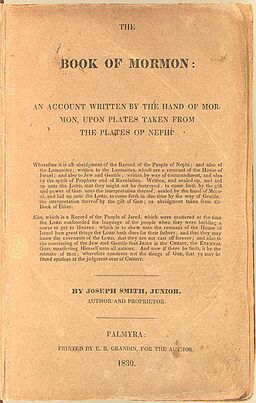The following was originally published on LDS Living in August 2015.
The first edition of the Book of Mormon was published more than 185 years ago, just before the Church was officially organized on the 6th of April 1830. E. B. Grandin agreed to publish the book at risk to his reputation, though with the possibility of great economic advantage.
The Book of Mormon is considered scripture by millions of Church members worldwide, but few today know the history of its first publication. Below is a list of five little-known facts about the first edition of the Book of Mormon.
1. The first portions of the Book of Mormon available to the public were pirated.
Using E. B. Grandin’s printing office in the evenings and on Sundays, Palmyra newspaperman Abner Cole printed a newspaper that caused some stir in the neighborhood. Cole felt called to spread enlightened thought to Americans. Writing under the pseudonym of Obediah Dogberry, he presented to his readers the first chance to read portions of the Book of Mormon. First Nephi, chapter 1; parts of First Nephi, chapter 2; and parts of Alma, chapter 43 were published in three of his January 1830 issues.
When the Smith family learned that Cole was printing unauthorized excerpts from the Book of Mormon, they sent for Joseph Smith, who was living in Harmony, Pennsylvania. Joseph Smith successfully convinced Cole to stop pirating the text, but the excerpts printed in Cole’s Reflector still represent the first time any Book of Mormon text was available to the public.
2. A non-Latter-day Saint played an essential role in how we read the Book of Mormon today.
The printer’s manuscript of the Book of Mormon was not punctuated. Non-Latter-day Saint typesetter John H. Gilbert recalled later in his life that he punctuated most of the Book of Mormon, at times interpreting the tricky wording of the text. Gilbert’s punctuation still influences the punctuation found in the current English edition of the Book of Mormon. So, in a small way, a non-Latter-day Saint assisted millions of Latter-day Saints in reading this sacred scripture.

Photo from Wikimedia Commons
3. The book order for the Book of Mormon was 5 to 25 times greater than other books of its day.
When Joseph Smith, Oliver Cowdery, and Martin Harris entered an agreement with E. B. Grandin to publish the Book of Mormon, they jointly agreed that Grandin would publish 5,000 copies of the book for $3,000. In a day when a common print run was less than 1,000 copies—and sometimes just a few hundred—this print run represented a significant commitment by Grandin and those who financially backed the publication. Only the Bible or similarly significant texts of the day were printed in such large quantities. Joseph Smith and others had great optimism that this text would sell and be meaningful to its readers.
4. The binding for the Book of Mormon mirrored the Bible.
In the early 19th century, books were sometimes sold without having been bound. But the way the Book of Mormon was bound sent a strong signal about its importance before readers even opened the covers: the binding’s material, colors, and design mimicked one of the most common bindings of a popular Bible of the time. When placed on the shelf, the 1830 Book of Mormon and the Bible would have looked similar.
5. The Book of Mormon manuscripts have their own interesting history.
When Joseph Smith finished dictating the text of the Book of Mormon to Oliver Cowdery, he instructed Cowdery to make a second copy. The original Book of Mormon manuscript was kept by Joseph Smith until it was deposited in the cornerstone of the Nauvoo House in 1841. Over time, much of that manuscript was destroyed by water or mold.
The second copy of the Book of Mormon manuscript, often called the “printer’s manuscript,” was used by compositors to set the type for the first edition in 1830. The printer’s manuscript was used again for the second edition, which was published in Kirtland, Ohio, in 1837. David Whitmer, one of the three witnesses to the Book of Mormon plates, was the eventual custodian of the printer’s manuscript. Later in his life, Whitmer enjoyed telling people how the manuscript was miraculously preserved from a tornado and from potential thieves.
Eventually, the manuscript was acquired by the Reorganized Church of Jesus Christ of Latter-day Saints (now the Community of Christ). Their careful custodianship of this manuscript through the generations has enabled study of this important text.

